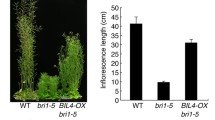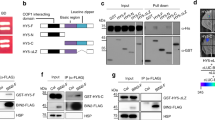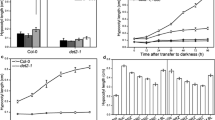Abstract
Hypocotyl length is determined by cell division and elongation, which are associated with canonical cell cycle and endoreduplication. Plant hormone brassinosteroid (BR) is required for hypocotyl elongation under light while the roles of canonical cell cycle and endoreduplication in brassinosteroid-modulated hypocotyl elongation remain unclear. Here, we observed that brassinosteroid biosynthesis inhibitor brassinazole (BRZ) inhibited tomato hypocotyl elongation through inhibition of canonical cell cycle in the longitudinal direction, which was associated with the downregulation of cell cycle gene expression. Transcriptions of cell elongation gene SlRPEs were also repressed by BRZ during hypocotyl elongation which were positively correlated with the transcriptions of cell cycle genes. Analyses of cis-elements revealed that cyclin genes contained multiple E-box and BRRE motifs in the promoters, which were considered as BR-activated transcription factor BZR1 binding sites. Promoter activity assay using SlCYCU4;1 promoter-driven GUS revealed that BZR1 could activate SlCYCU4;1 transcription. We then analyzed nuclear DNA ploidy level and transcription of cell cycle genes in tomato cultivar ‘Micro-Tom’ which is a BR biosynthesis mutant showing dwarf morphology. Similar to the BRZ treatment, canonical cell cycle in the longitudinal direction was inhibited, and transcriptions of cell cycle genes and SlRPEs were repressed in ‘Micro-Tom’. Taken together, our results establish a connection between BR, canonical cell cycle and cell cycle genes, suggesting that inhibition of BR represses cell cycle genes to inhibit longitudinal cell division and consequent hypocotyl elongation.






Similar content being viewed by others
References
Anwar A, Yan Y, Liu Y, Li Y, Yu X (2018) 5-aminolevulinic acid improves nutrient uptake and endogenous hormone accumulation, enhancing low-temperature stress tolerance in cucumbers. Int J Mol Sci. 19(11). https://doi.org/10.3390/ijms19113379
Arumuganathan K, Earle ED (1991) Estimation of nuclear DNA content of plants by flow cytometry. Plant Mol Biol Report 9(3):229–241. https://doi.org/10.1007/bf02672073
Bainard JD, Bainard LD, Henry TA, Fazekas AJ, Newmaster SG (2012) A multivariate analysis of variation in genome size and endoreduplication in angiosperms reveals strong phylogenetic signal and association with phenotypic traits. New Phytol 196(4):1240–1250. https://doi.org/10.1111/j.1469-8137.2012.04370.x
Bao Z, Yang H, Hua J (2013) Perturbation of cell cycle regulation triggers plant immune response via activation of disease resistance genes. Proc Natl Acad Sci USA 110(6):2407–2412. https://doi.org/10.1073/pnas.1217024110
Bao Z, Zhang N, Hua J (2014) Endopolyploidization and flowering time are antagonistically regulated by checkpoint component MAD1 and immunity modulator MOS1. Nat Commun 5:5628. https://doi.org/10.1038/ncomms6628
Barow M, Meister A (2003) Endopolyploidy in seed plants is differently correlated to systematics, organ, life strategy and genome size. Plant Cell Environ 26:571–584. https://doi.org/10.1046/j.1365-3040.2003.00988.x
Bishop GJ, Nomura T, Yokota T, Harrison K, Noguchi T, Fujioka S, Takatsuto S, Jones JD, Kamiya Y (1999) The tomato DWARF enzyme catalyses C-6 oxidation in brassinosteroid biosynthesis. Proc Natl Acad Sci U S A 96(4):1761–1766. https://doi.org/10.1073/pnas.96.4.1761
Chen YX, Sun SY, Wang XL (2020) The epidermis-specific cyclin CYCP3;1 is involved in the excess brassinosteroid signaling-inhibited root meristem cell division. J Integr Plant Biol 62(11):1674–1687. https://doi.org/10.1111/jipb.12975
Chevalier C, Bourdon M, Pirrello J, Cheniclet C, Gevaudant F, Frangne N (2014) Endoreduplication and fruit growth in tomato: evidence in favour of the karyoplasmic ratio theory. J Exp Bot 65(10):2731–2746. https://doi.org/10.1093/jxb/ert366
Cockcroft CE, den Boer BG, Healy JM, Murray JA (2000) Cyclin D control of growth rate in plants. Nature 405(6786):575–579. https://doi.org/10.1038/35014621
Cui L, Zheng F, Wang J, Zhang C, Xiao F, Ye J, Li C, Ye Z, Zhang J (2020) miR156a-targeted SBP-Box transcription factor SlSPL13 regulates inflorescence morphogenesis by directly activating SFT in tomato. Plant Biotechnol J 18(8):1670–1682. https://doi.org/10.1111/pbi.13331
Desvoyes B, Arana-Echarri A, Barea MD, Gutierrez C (2020) A comprehensive fluorescent sensor for spatiotemporal cell cycle analysis in Arabidopsis. Nat Plants 6(11):1330–1334. https://doi.org/10.1038/s41477-020-00770-4
Faustova I, Bulatovic L, Matiyevskaya F, Valk E, Ord M, Loog M (2021) A new linear cyclin docking motif that mediates exclusively S-phase CDK-specific signaling. Embo J 40(2). https://doi.org/10.15252/embj.2020105839
Fujioka S, Li J, Choi YH, Seto H, Takatsuto S, Noguchi T, Watanabe T, Kuriyama H, Yokota T, Chory J, Sakurai A (1997) The Arabidopsis deetiolated2 mutant is blocked early in brassinosteroid biosynthesis. Plant Cell 9(11):1951–1962. https://doi.org/10.1105/tpc.9.11.1951
Gomez C, Mitchell CA (2014) Growth responses of greenhouse tomato seedlings to different spectra of supplemental lighting are season-specific in a northern climate. HortScience 49(9):S273–S273
Groszyk J, Szechynska-Hebda M (2021) Effects of 24-epibrassinolide, bikinin, and brassinazole on barley growth under salinity stress are genotype- and dose-dependent. Agronomy-Basel 11(2). https://doi.org/10.3390/agronomy11020259
Guo AY, Zhu QH, Chen X, Luo JC (2007) GSDS: a gene structure display server. Yi Chuan 29(8):1023–1026
Gupta A, Hua L, Lin GF, Molnar I, Dolezel J, Liu SZ, Li WL (2021) Multiple origins of Indian dwarf wheat by mutations targeting the TREE domain of a GSK3-like kinase for drought tolerance, phosphate uptake, and grain quality. Theor Appl Genet 134(2):633–645
Hegarat N, Crncec A, Rodriguez MFSP, Iturra FE, Gu Y, Busby O, Lang PF, Barr AR, Bakal C, Kanemaki MT, Lamond AI, Novak B, Ly T, Hochegger H (2020) Cyclin A triggers Mitosis either via the Greatwall kinase pathway or Cyclin B. Embo J 39(11). https://doi.org/10.15252/embj.2020104419
Heidari P, Entazari M, Amin, Ahmadizadeh M, Vannozzi A, Palumbo F, Barcaccia G (2021) Exogenous EBR ameliorates endogenous hormone contents in tomato species under low-temperature stress. Horticulturae 7(4). https://doi.org/10.3390/horticulturae7040084
Huang GM, Liu YR, Guo YL, Peng CX, Tan WM, Zhang MC, Li ZH, Zhou YY, Duan LS (2021) A novel plant growth regulator improves the grain yield of high-density maize crops by reducing stalk lodging and promoting a compact plant type. Field Crop Res 260
Hussain MA, Fahad S, Sharif R, Jan MF, Mujtaba M, Ali Q, Ahmad A, Ahmad H, Amin N, Ajayo BS, Sun CB, Gu LY, Ahmad I, Jiang ZM, Hou JC (2020) Multifunctional role of brassinosteroid and its analogues in plants. Plant Growth Regul 92(2):141–156. https://doi.org/10.1007/s10725-020-00647-8
Ibanez C, Delker C, Martinez C, Burstenbinder K, Janitza P, Lippmann R, Ludwig W, Sun H, James GV, Klecker M, Grossjohann A, Schneeberger K, Prat S, Quint M (2018) Brassinosteroids dominate hormonal regulation of plant thermomorphogenesis via BZR1. Curr Biol 28(2):303–310. https://doi.org/10.1016/j.cub.2017.11.077
Kakuszi A, Sarvari E, Solti A, Czegeny G, Hideg E, Hunyadi-Gulyas E, Boka K, Boddi B (2016) Light piping driven photosynthesis in the soil: Low-light adapted active photosynthetic apparatus in the under-soil hypocotyl segments of bean (Phaseolus vulgaris). J Photoch Photobio B 161:422–429. https://doi.org/10.1016/j.jphotobiol.2016.06.009
Khalaki MA, Moameri M, Lajayer BA, Astatkie T (2021) Influence of nano-priming on seed germination and plant growth of forage and medicinal plants. Plant Growth Regul 93(1):13–28. https://doi.org/10.1007/s10725-020-00670-9
Kumar S, Stecher G, Li M, Knyaz C, Tamura K (2018) MEGA X: molecular evolutionary genetics analysis across computing platforms. Mol Biol Evol 35(6):1547–1549. https://doi.org/10.1093/molbev/msy096
Lee J, Shim D, Moon S, Kim H, Bae W, Kim K, Kim YH, Rhee SK, Hong CP, Hong SY, Lee YJ, Sung J, Ryu H (2018) Genome-wide transcriptomic analysis of BR-deficient Micro-Tom reveals correlations between drought stress tolerance and brassinosteroid signaling in tomato. Plant Physiol Biochem 127:553–560. https://doi.org/10.1016/j.plaphy.2018.04.031
Li J, Sohail H, Nawaz MA, Liu CW, Yang P (2021a) Physiological and proteomic analyses reveals that brassinosteroids application improves the chilling stress tolerance of pepper seedlings. Plant Growth Regul
Li J, Terzaghi W, Gong Y, Li C, Ling JJ, Fan Y, Qin N, Gong X, Zhu D, Deng XW (2020) Modulation of BIN2 kinase activity by HY5 controls hypocotyl elongation in the light. Nat Commun 11(1):1592. https://doi.org/10.1038/s41467-020-15394-7
Li SM, Zheng HX, Lin L, Wang F, Sui N (2021b) Roles of brassinosteroids in plant growth and abiotic stress response. Plant Growth Regul 93(1):29–38
Li XJ, Chen XJ, Guo X, Yin LL, Ahammed GJ, Xu CJ, Chen KS, Liu CC, Xia XJ, Shi K, Zhou J, Zhou YH, Yu JQ (2016) DWARF overexpression induces alteration in phytohormone homeostasis, development, architecture and carotenoid accumulation in tomato. Plant Biotechnol J 14(3):1021–1033
Liu Y, Roof S, Ye Z, Barry C, van Tuinen A, Vrebalov J, Bowler C, Giovannoni J (2004) Manipulation of light signal transduction as a means of modifying fruit nutritional quality in tomato. Proc Natl Acad Sci USA 101(26):9897–9902. https://doi.org/10.1073/pnas.0400935101
Marti E, Gisbert C, Bishop GJ, Dixon MS, Garcia-Martinez JL (2006) Genetic and physiological characterization of tomato cv. Micro-Tom J Exp Bot 57(9):2037–2047. https://doi.org/10.1093/jxb/erj154
Okello RCO, de Visser PHB, Heuvelink E, Marcelis LFM, Struik PC (2016) Light mediated regulation of cell division, endoreduplication and cell expansion. Environ Exp Bot 121:39–47
Saadati S, Baninasab B, Mobli M, Gholami M (2021) Enhancement of freezing tolerance of olive leaves by foliar application of methyl jasmonate and 24-epibrassinolide through changes in some metabolites and antioxidant activity. Sci Hortic-Amsterdam. https://doi.org/10.1016/j.scienta.2021.12710
Sugimoto-Shirasu K, Roberts K (2003) “Big it up”: endoreduplication and cell-size control in plants. Curr Opin Plant Biol 6(6):544–553. https://doi.org/10.1016/j.pbi.2003.09.009
Sun F, Yu H, Qu J, Cao Y, Ding L, Feng W, Khalid MHB, Li W, Fu F (2020) Maize ZmBES1/BZR1–5 Decreases ABA sensitivity and confers tolerance to osmotic stress in transgenic arabidopsis. Int J Mol Sci 21(3). https://doi.org/10.3390/ijms21030996
Takahashi N, Nakazawa M, Shibata K, Yokota T, Ishikawa A, Suzuki K, Kawashima M, Ichikawa T, Shimada H, Matsui M (2005) shk1-D, a dwarf Arabidopsis mutant caused by activation of the CYP72C1 gene, has altered brassinosteroid levels. Plant J 42(1):13–22. https://doi.org/10.1111/j.1365-313X.2005.02357.x
Tanaka K, Asami T, Yoshida S, Nakamura Y, Matsuo T, Okamoto S (2005) Brassinosteroid homeostasis in Arabidopsis is ensured by feedback expressions of multiple genes involved in its metabolism. Plant Physiol 138(2):1117–1125. https://doi.org/10.1104/pp.104.058040
Tang QY, Zhang CX (2013) Data Processing System (DPS) software with experimental design, statistical analysis and data mining developed for use in entomological research. Insect Sci 20(2):254–260. https://doi.org/10.1111/j.1744-7917.2012.01519.x
Tong H, Chu C (2018) Functional specificities of brassinosteroid and potential utilization for crop improvement. Trends Plant Sci 23(11):1016–1028. https://doi.org/10.1016/j.tplants.2018.08.007
Trolet A, Baldrich P, Criqui MC, Dubois M, Clavel M, Meyers BC, Genschik P (2019) Cell cycle-dependent regulation and function of ARGONAUTE1 in plants. Plant Cell 31(8):1734–1750. https://doi.org/10.1105/tpc.19.00069
Tsuchiya M, Satoh S, Iwai H (2015) Distribution of XTH, expansin, and secondary-wall-related CesA in floral and fruit abscission zones during fruit development in tomato (Solanum lycopersicum). Front Plant Sci 6:323. https://doi.org/10.3389/fpls.2015.00323
Wu G, Carville JS, Spalding EP (2016) ABCB19-mediated polar auxin transport modulates Arabidopsis hypocotyl elongation and the endoreplication variant of the cell cycle. Plant J 85(2):209–218. https://doi.org/10.1111/tpj.13095
Yin Y, Qin K, Song X, Zhang Q, Zhou Y, Xia X, Yu J (2018) BZR1 transcription factor regulates heat stress tolerance through FERONIA receptor-like kinase-mediated reactive oxygen species signaling in tomato. Plant Cell Physiol 59(11):2239–2254. https://doi.org/10.1093/pcp/pcy146
Yu Y, Steinmetz A, Meyer D, Brown S, Shen WH (2003) The tobacco A-type cyclin, Nicta;CYCA3;2, at the nexus of cell division and differentiation. Plant Cell 15(12):2763–2777. https://doi.org/10.1105/tpc.015990
Zhang KY, Pan JS, Chen Y, Wei Y, Du H, Sun JX, Lv D, Wen HF, He HL, Wang G, Cai R (2021) Mapping and identification of CsSh5.1, a gene encoding a xyloglucan galactosyltransferase required for hypocotyl elongation in cucumber (Cucumis sativus L.). Theor Appl Genet 134(4):979–991
Zhang WF, Tan LB, Sun HY, Zhao XH, Liu FX, Cai HW, Fu YC, Sun XY, Gu P, Zhu ZF, Sun CQ (2019) Natural variations at TIG1 encoding a TCP transcription factor contribute to plant architecture domestication in rice. Mol Plant 12(8):1075–1089. https://doi.org/10.1016/j.molp.2019.04.005
Zhu WJ, Jiao DL, Zhang J, Xue CM, Chen M, Yang Q (2020) Genome-wide identification and analysis of BES1/BZR1 transcription factor family in potato (Solanum tuberosum L.). Plant Growth Regul 92(2):375–387
Zhu Z, Chen G, Guo X, Yin W, Yu X, Hu J, Hu Z (2017) Overexpression of SlPRE2, an atypical bHLH transcription factor, affects plant morphology and fruit pigment accumulation in tomato. Sci Rep 7(1):5786. https://doi.org/10.1038/s41598-017-04092-y
Zhu ZG, Liang HL, Chen GP, Tang BY, Tian SB, Hu ZL (2019) Isolation of the brassinosteroid receptor genes and recharacterization of dwarf plants by silencing of SlBRI1 in tomato. Plant Growth Regul 89(1):59–71
Acknowledgements
This research was supported by Agricultural Seed Project of Shandong Province (2020LZGC005 to Z.B.), Taishan Scholar Foundation of Shandong Province (tsqn201812034 to Z.B.) and National Natural Science Foundation of China (31872951 to Z.B.). We thank Tomato Genetics Resource Center (TGRC) to provide tomato seeds. We thank plant growth facility members in the state key laboratory of crop biology at Shandong Agricultural University.
Funding
This work was supported by Agricultural Seed Project of Shandong Province (2020LZGC005 to Z.B.), Taishan Scholar Foundation of Shandong Province (tsqn201812034 to Z.B.) and National Natural Science Foundation of China (31872951 to Z.B.).
Author information
Authors and Affiliations
Contributions
GL, FM and ZB conceived and designed the experiments. SS and GL performed most of experiments. SS and GL analyzed the data. GL, FM and ZB wrote the manuscript.
Corresponding authors
Ethics declarations
Conflict of interest
The authors declare no potential conflict of interest.
Additional information
Communicated by Dawei Xue.
Publisher's Note
Springer Nature remains neutral with regard to jurisdictional claims in published maps and institutional affiliations.
Supplementary Information
Below is the link to the electronic supplementary material.
Rights and permissions
About this article
Cite this article
Song, S., Liu, G., Ma, F. et al. Brassinazole represses tomato hypocotyl elongation via inhibition of cell division. Plant Growth Regul 96, 463–472 (2022). https://doi.org/10.1007/s10725-022-00798-w
Received:
Accepted:
Published:
Issue Date:
DOI: https://doi.org/10.1007/s10725-022-00798-w




